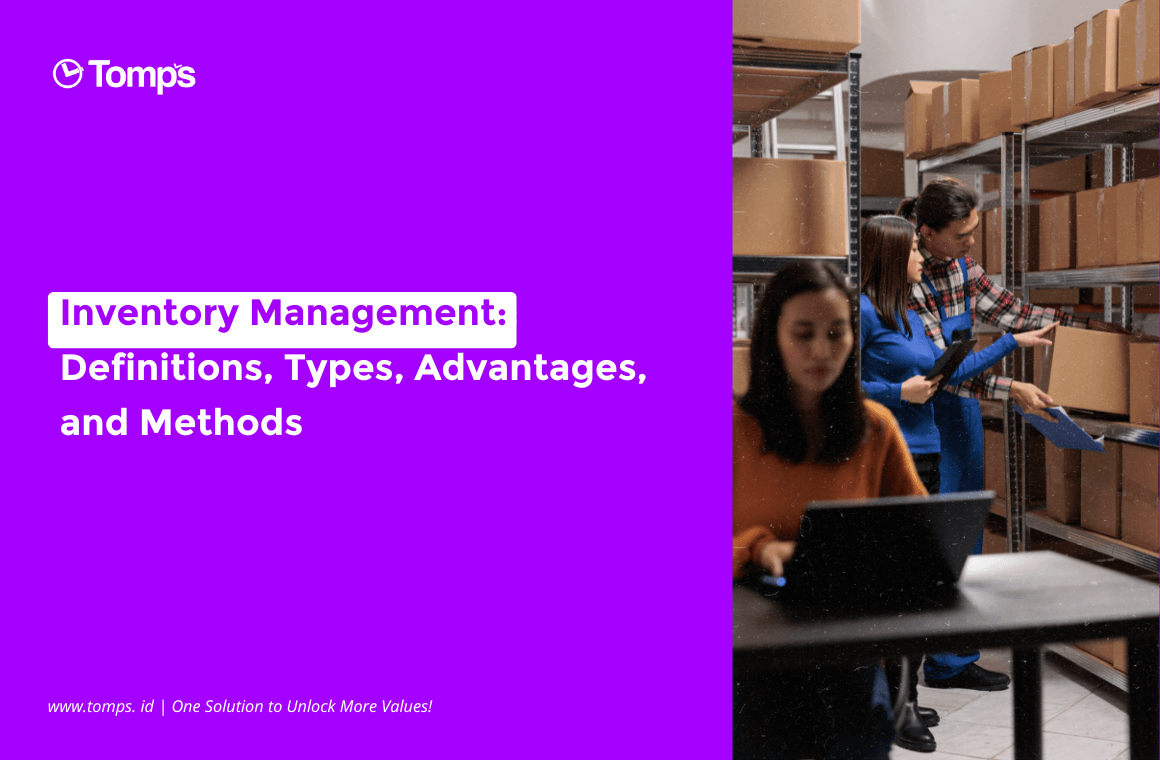Inventory management has a central role in every aspect of business operations and has a direct impact on a company's performance. In this article, we will comprehensively review the topic of inventory management, which includes understanding its relevance in a business context, optimal strategies, obstacles that are often faced, and the impact of technological developments on company inventory management methods.
Get to know Inventory Management
According to Prieds, the Inventory Management System is a series of procedures implemented to supervise, manage, and monitor the stock of goods within the business scope. This system provides support to businesses in streamlining the procurement, management, and delivery of goods. There are several variations of inventory management systems, including manual approaches, computer-based implementation, and the use of RFID (Radio Frequency Identification) technology.
The Importance of Inventory Management
Anticipate potential problems
In order to anticipate potential problems arising from delays in the delivery of raw materials, a wise action for companies engaged in production is to ensure the availability of raw materials in stock. This aims to reduce dependence on suppliers in terms of quantity and delivery time. Additionally, having work-in-process stock allows each part involved in production to have more flexibility in meeting production needs. Providing additional raw material supplies is also a solution to deal with fluctuating demand from customers.
Minimise receiving inappropriate orders
The risk of receiving orders for materials that do not meet the specifications required by the company is unforeseen. Although incidents like this are rare, companies must always be prepared to deal with them. Ensuring that the goods received match requirements is key, and if a discrepancy occurs, the production process must continue without a hitch. This is where inventory management plays a vital role in maintaining the company's smooth operations.
Planning raw material storage
Some raw materials are only available at certain times, which can be influenced by various factors such as natural conditions and weather. The existence of these materials may become rare in certain periods. In dealing with this situation, companies need to plan seasonal storage of raw materials so as not to be hampered by unavailability on the market.
Monitoring the Availability of Production Materials
Production activities that run without obstacles are a key factor in ensuring the sustainability and profitability of companies operating in the manufacturing sector. In order to ensure the production process runs smoothly, inventory management plays a very important role. When production materials are well available, the production process can run according to schedule and is not disrupted.
Utilising Production Machines Optimally
Optimal utilisation of production machines is an important element in avoiding the waste of resources and costs. Investing in these machines requires significant funds; therefore, using them efficiently is the key to minimising losses.
Monitoring raw material availability
Once a company has gained customer trust, it is important to maintain product quality and supply stability. Efficient inventory management can help ensure the availability of raw materials needed to maintain market needs. With this, the company can continue to meet market demand with the consistency necessary to maintain customer satisfaction.
Inventory Management Method
According to SAP Express, there are several methods of inventory management, namely:
Just in Time (JIT)
The JIT method is an inventory management strategy where the purchase or production of raw materials or finished goods is only carried out when needed. By implementing the JIT method, companies can avoid inventory costs, increase production efficiency and flexibility, and maximise warehouse space utilisation.
However, the JIT method also poses a number of risks, such as potential disruptions in production when the supply of raw materials is late or of poor quality or when there is a sudden spike in customer demand. Therefore, implementing the JIT method needs to be done carefully and with careful planning.
Materials Requirement Planning (MRP)
The MRP method is an inventory management strategy where raw material inventory is continuously monitored in real-time and the system automatically generates orders to ensure inventory availability is always as needed. By implementing the MRP method, companies can avoid unnecessary inventory costs, increase production efficiency, and respond to customer requests in a timely manner.
However, the MRP method also has certain risks, such as the risk of excessive or insufficient inventory, which can affect inventory and shipping costs. Therefore, the application of the MRP method needs to be done with caution and strict supervision.
Economic Order Quantity (EOQ)
The EOQ method is an inventory management strategy in which a company determines the optimal order quantity based on ordering costs and carrying costs. By implementing the EOQ method, companies can optimise inventory costs and ensure inventory availability is always as needed.
However, the EOQ method also carries certain risks, such as the potential for over- or under-inventory, which can affect inventory and shipping costs. Therefore, the application of the EOQ method needs to be done with caution and careful planning.
Days Sales of Inventory (DSI)
The DSI method is an inventory management strategy in which companies measure the average number of days' inventory available for sale. By implementing the DSI method, companies can continue to monitor and optimise inventory in real-time and ensure inventory availability is always as needed.
However, this method also has certain risks, such as the risk of over- or under-inventory, which can affect inventory and shipping costs. Therefore, the application of the DSI method needs to be done with caution and strict supervision.
Benefits of Inventory Management
Achievement of Delivery Accuracy
Increase the transparency of your stock and ensure that customers receive appropriate orders or avoid out-of-stock orders from the website or through the sales team. Reduce inaccuracies in order delivery, high returns, and lost customers.
Efficient inventory planning and ordering
Another advantage of inventory management is the efficient planning and ordering of goods. With good inventory management, you will get a clearer picture of your inventory, avoid overstocks or understocks, and maintain inventory levels that match demand for best-selling items.
Improved warehouse management
Proper inventory management can result in better order fulfilment, improved quality control, storage management, inventory movement, employee movement, labour efficiency, and reduced employee risk. Inventory management is the first step you need to take to improve your warehouse operations.
Conclusion
Inventory management is an important element in business operations that has a significant impact on the company's success. By implementing optimal inventory management, companies can increase delivery accuracy, avoid wasted costs, and prevent losing customers due to insufficient or excessive stock. In addition, effective inventory management also supports appropriate inventory planning and ordering, maintaining standards of excellence in warehouse management, and increasing overall operational efficiency. Efficient inventory management is the key to maintaining smooth business operations, reducing costs, and meeting customer needs well.
Every company requires monitoring of its assets and inventory to be able to achieve predetermined business goals. Tomps Asset is a platform specifically designed to assist companies in the management of their physical assets and inventory, so it has a strong connection to inventory management concepts and practices.
Sources:
Advotics. (2022, December 29). Proses Manajemen Inventory dan Metode Penerapannya. Advotics. https://www.advotics.com/id/manajemen-inventory-dan-metode-penerapan/
Aldo Dwi Kristian. (2023, February 24). Inventory Management System: Pengertian, Fungsi, dan Metode. PRIEDS; PRIEDS. https://www.prieds.com/post/inventory-management-system
iMpulse Digital. (2023, April 7). Pahami Apa itu Manajemen Inventory dan Manfaatnya Bagi Bisnis. SAP Express. https://www.sap-express.id/blog/manajemen-inventory/#:~:text=Pengertian%20Manajemen%20Inventory,serta%20pemrosesan%20barang%2Dbarang%20tersebut
Jenkins, A. (2020, September 18). What is Inventory Management? Benefits, Types, & Techniques. Oracle NetSuite; Oracle NetSuite. https://www.netsuite.com/portal/resource/articles/inventory-management/inventory-management.shtml
Nuraini Anitasari. (2021, August 5). 4 Fungsi Manajemen Inventory dan Peran Pentingnya - Zahir. Zahir Accounting Blog. https://zahiraccounting.com/id/blog/pentingnya-manajemen-inventory/







